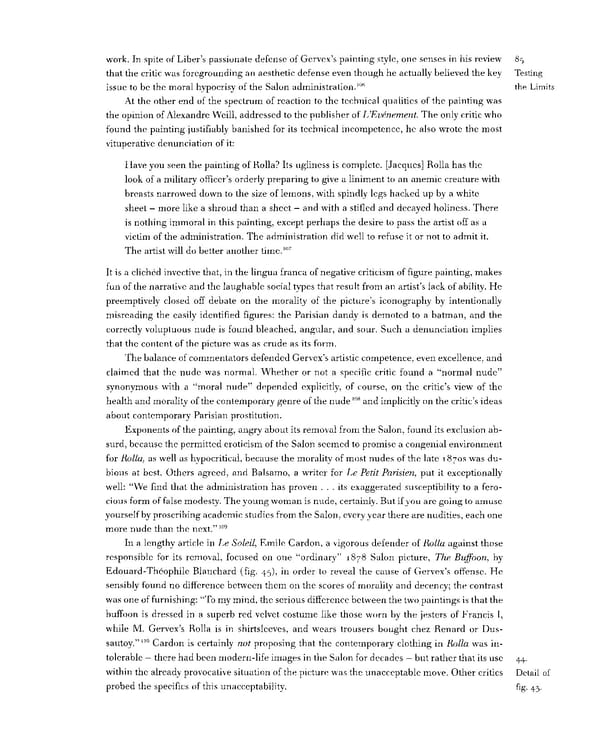work. In spite of Liber's passionate defense of Gervex's painting style, one senses in his review 85 that the critic was foregrounding an aesthetic defense even though he actually believed the key Testing 106 the Limits issue to be the moral hypocrisy of the Salon administration. At the other end of the spectrum of reaction to the technical qualities of the painting was the opinion of Alexandre Weill, addressed to the publisher of L'Evenement. The only critic who found the painting justifiably banished for its technical incompetence, he also wrote the most vituperative denunciation of it: Have you seen the painting of Rolla? Its ugliness is complete. [Jacques] Rolla has the look of a military officer's orderly preparing to give a liniment to an anemic creature with breasts narrowed down to the size of lemons, with spindly legs hacked up by a white sheet - more like a shroud than a sheet - and with a stifled and decayed holiness. There is nothing immoral in this painting, except perhaps the desire to pass the artist off as a victim of the administration. The administration did well to refuse it or not to admit it. 107 The artist will do better another time. It is a cliched invective that, in the lingua franca of negative criticism of figure painting, makes fun of the narrative and the laughable social types that result from an artist's lack of ability. He preemptively closed off debate on the morality of the picture's iconography by intentionally misreading the easily identified figures: the Parisian dandy is demoted to a batman, and the correctly voluptuous nude is found bleached, angular, and sour. Such a denunciation implies that the content of the picture was as crude as its form. The balance of commentators defended Gervex's artistic competence, even excellence, and claimed that the nude was normal. Whether or not a specific critic found a "normal nude" synonymous with a "moral nude" depended explicitly, of course, on the critic's view of the health and morality of the contemporary genre of the nude108 and implicitly on the critic's ideas about contemporary Parisian prostitution. Exponents of the painting, angry about its removal from the Salon, found its exclusion ab- surd, because the permitted eroticism of the Salon seemed to promise a congenial environment for Rolla, as well as hypocritical, because the morality of most nudes of the late 18708 was du- bious at best. Others agreed, and Balsamo, a writer for Le Petit Parisien, put it exceptionally well: "We find that the administration has proven ... its exaggerated susceptibility to a fero- cious form of false modesty. The young woman is nude, certainly. But if you are going to amuse yourself by proscribing academic studies from the Salon, every year there are nudities, each one 109 more nude than the next." In a lengthy article in Le Soleil, Emile Cardon, a vigorous defender of Rolla against those responsible for its removal, focused on one "ordinary" 1878 Salon picture, The Buffoon, by Edouard-Theophile Blanchard (fig. 45), in order to reveal the cause of Gervex's offense. He sensibly found no difference between them on the scores of morality and decency; the contrast was one of furnishing: "To my mind, the serious difference between the two paintings is that the buffoon is dressed in a superb red velvet costume like those worn by the jesters of Francis I, while M. Gervex's Rolla is in shirtsleeves, and wears trousers bought chez Renard or Dus- 110 sautoy." certainly not proposing that the contemporary clothing in Rolla was in- Cardon is tolerable — there had been modern-life images in the Salon for decades — but rather that its use 44. within the already provocative situation of the picture was the unacceptable move. Other critics Detail of probed the specifics of this unacceptability. % 43-
 Prostitution & Impressionists Page 105 Page 107
Prostitution & Impressionists Page 105 Page 107